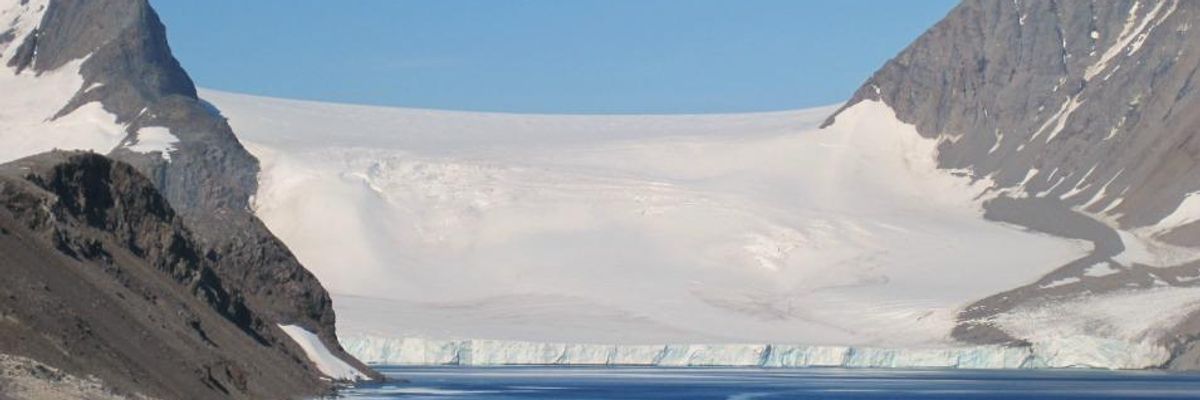

SUBSCRIBE TO OUR FREE NEWSLETTER
Daily news & progressive opinion—funded by the people, not the corporations—delivered straight to your inbox.
5
#000000
#FFFFFF
To donate by check, phone, or other method, see our More Ways to Give page.


Daily news & progressive opinion—funded by the people, not the corporations—delivered straight to your inbox.

Hope Bay glacier, 2012. (Photo: Travellers & Tinkers/Wikimedia/cc)
A group of scientists on Thursday published evidence that the Southern Antarctic Peninsula, a region where glaciers were previously thought to be stable, is now undergoing sudden--and dramatic--ice loss due to the warming of the ocean.
Published in the journal Science under the title Dynamic thinning of glaciers on the Southern Antarctic Peninsula, the research was led by a group of University of Bristol researchers.
A research summary explains, "Using measurements of the elevation of the Antarctic ice sheet made by a suite of satellites, the researchers found that the Southern Antarctic Peninsula showed no signs of change up to 2009."
However, the statement continues, "Around 2009, multiple glaciers along a vast coastal expanse, measuring some 750km in length, suddenly started to shed ice into the ocean at a nearly constant rate of 60 cubic km, or about 55 trillion litres of water, each year.
Lead researcher Dr. Bert Wouters, from the University of Bristol, said the findings "came as a surprise."
"To date, the glaciers added roughly 300 cubic km of water to the ocean," said Wouters. "That's the equivalent of the volume of nearly 350,000 Empire State Buildings combined."
The findings mean that the region "is the second largest contributor to sea level rise in Antarctica and the ice loss shows no sign of waning," say researchers.
This study comes on the heels of a NASA report released last week, which found that the Antarctic shelf is close to disintegration.
Trump and Musk are on an unconstitutional rampage, aiming for virtually every corner of the federal government. These two right-wing billionaires are targeting nurses, scientists, teachers, daycare providers, judges, veterans, air traffic controllers, and nuclear safety inspectors. No one is safe. The food stamps program, Social Security, Medicare, and Medicaid are next. It’s an unprecedented disaster and a five-alarm fire, but there will be a reckoning. The people did not vote for this. The American people do not want this dystopian hellscape that hides behind claims of “efficiency.” Still, in reality, it is all a giveaway to corporate interests and the libertarian dreams of far-right oligarchs like Musk. Common Dreams is playing a vital role by reporting day and night on this orgy of corruption and greed, as well as what everyday people can do to organize and fight back. As a people-powered nonprofit news outlet, we cover issues the corporate media never will, but we can only continue with our readers’ support. |
A group of scientists on Thursday published evidence that the Southern Antarctic Peninsula, a region where glaciers were previously thought to be stable, is now undergoing sudden--and dramatic--ice loss due to the warming of the ocean.
Published in the journal Science under the title Dynamic thinning of glaciers on the Southern Antarctic Peninsula, the research was led by a group of University of Bristol researchers.
A research summary explains, "Using measurements of the elevation of the Antarctic ice sheet made by a suite of satellites, the researchers found that the Southern Antarctic Peninsula showed no signs of change up to 2009."
However, the statement continues, "Around 2009, multiple glaciers along a vast coastal expanse, measuring some 750km in length, suddenly started to shed ice into the ocean at a nearly constant rate of 60 cubic km, or about 55 trillion litres of water, each year.
Lead researcher Dr. Bert Wouters, from the University of Bristol, said the findings "came as a surprise."
"To date, the glaciers added roughly 300 cubic km of water to the ocean," said Wouters. "That's the equivalent of the volume of nearly 350,000 Empire State Buildings combined."
The findings mean that the region "is the second largest contributor to sea level rise in Antarctica and the ice loss shows no sign of waning," say researchers.
This study comes on the heels of a NASA report released last week, which found that the Antarctic shelf is close to disintegration.
A group of scientists on Thursday published evidence that the Southern Antarctic Peninsula, a region where glaciers were previously thought to be stable, is now undergoing sudden--and dramatic--ice loss due to the warming of the ocean.
Published in the journal Science under the title Dynamic thinning of glaciers on the Southern Antarctic Peninsula, the research was led by a group of University of Bristol researchers.
A research summary explains, "Using measurements of the elevation of the Antarctic ice sheet made by a suite of satellites, the researchers found that the Southern Antarctic Peninsula showed no signs of change up to 2009."
However, the statement continues, "Around 2009, multiple glaciers along a vast coastal expanse, measuring some 750km in length, suddenly started to shed ice into the ocean at a nearly constant rate of 60 cubic km, or about 55 trillion litres of water, each year.
Lead researcher Dr. Bert Wouters, from the University of Bristol, said the findings "came as a surprise."
"To date, the glaciers added roughly 300 cubic km of water to the ocean," said Wouters. "That's the equivalent of the volume of nearly 350,000 Empire State Buildings combined."
The findings mean that the region "is the second largest contributor to sea level rise in Antarctica and the ice loss shows no sign of waning," say researchers.
This study comes on the heels of a NASA report released last week, which found that the Antarctic shelf is close to disintegration.